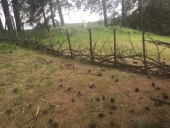
 1
1





 1
1




"Never doubt that a small group of thoughtful, committed citizens can change the world; indeed, it's the only thing that ever has."-Margaret Mead "The only thing worse than being blind, is having sight but no vision."-Helen Keller




Roberto pokachinni wrote:I suspect that it would vary greatly on species and on your region's ability for rapid regeneration. Example: Poplar reproduces volume of biomass much quicker than Douglas fir, but a mature Doug Fir forest has much more biomass than a mature poplar forest. However, if you cut a tenth of the poplar, the regeneration of the poplar grove (through clonal shoots) will be much more rapid and complete than harvesting 10% of a Doug Fir forest. Also the quantity or mass of fungi that associate with the longer term forest probably has a role in carbon sequestering that should be at least considered.














Just be sure the cottonwood is good and dead before putting it in your hugulkultur or you will be growing more cottonwood than food in your mound.I like the idea of poop making cottonwoods, cottonwoods making hugelkutur, hugelkultur making food and food making poop.
"Never doubt that a small group of thoughtful, committed citizens can change the world; indeed, it's the only thing that ever has."-Margaret Mead "The only thing worse than being blind, is having sight but no vision."-Helen Keller




Author 'Perennial Vegetables', co-author 'Edible Forest Gardens'.
Website - http://www.perennialsolutions.org/




Xisca - pics! Dry subtropical Mediterranean - My project
However loud I tell it, this is never a truth, only my experience...














"Never doubt that a small group of thoughtful, committed citizens can change the world; indeed, it's the only thing that ever has."-Margaret Mead "The only thing worse than being blind, is having sight but no vision."-Helen Keller




"The rule of no realm is mine. But all worthy things that are in peril as the world now stands, these are my care. And for my part, I shall not wholly fail in my task if anything that passes through this night can still grow fairer or bear fruit and flower again in days to come. For I too am a steward. Did you not know?" Gandolf




Roberto pokachinni wrote:
Just be sure the cottonwood is good and dead before putting it in your hugulkultur or you will be growing more cottonwood than food in your mound.I like the idea of poop making cottonwoods, cottonwoods making hugelkutur, hugelkultur making food and food making poop.
Marco Banks wrote:Further, 60% of a plants energy is directed below the ground, given to root growth and root exudates. The larger the plant, the greater the volume of root exudates they are pumping into the soil food web.
















Idle dreamer





|
"Ace of Hearts" sounds a little like "Ace o Farts" - says this tiny ad:
The new permaculture playing cards kickstarter is now live!
https://www.kickstarter.com/projects/paulwheaton/garden-cards
|








